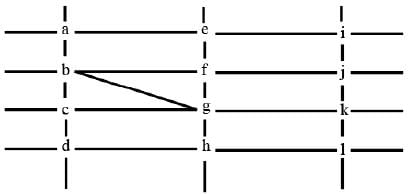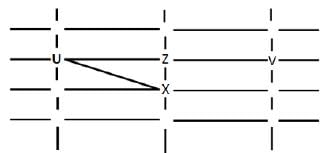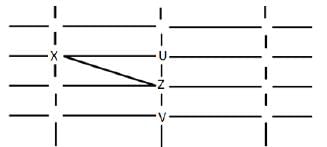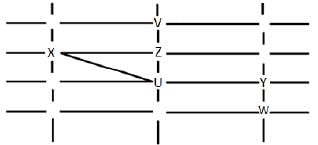CAT Exam > CAT Questions > The figure below shows the street map for a ...
Start Learning for Free
The figure below shows the street map for a certain region with the street intersections marked from a through l. A person standing at an intersection can see along straight lines to other intersections that are in her line of sight and all other people standing at these intersections. For example, a person standing at intersection g can see all people standing at intersections b, c, e, f, h, and k. In particular, the person standing at intersection g can see the person standing at intersection e irrespective of whether there is a person standing at intersection f.

Six people U, V, W, X, Y, and Z, are standing at different intersections. No two people are standing at the same intersection.
The following additional facts are known.
1. X, U, and Z are standing at the three corners of a triangle formed by three street segments.
2. X can see only U and Z.
3. Y can see only U and W.
4. U sees V standing in the next intersection behind Z.
5. W cannot see V or Z.
6. No one among the six is standing at intersection d.
Q. Who can V see?
- a)Z only
- b)U, W and Z only
- c)U and Z only
- d)U only
Correct answer is option 'C'. Can you explain this answer?
| FREE This question is part of | Download PDF Attempt this Test |
Verified Answer
The figure below shows the street map for a certain region with the s...

From 1, X, U, and Z are standing at the three corners of a triangle formed by three street segments.
From 2, X can see only U and Z.
From 4, U sees V standing in the next intersection behind Z. Also, no one among the six is standing at intersection d.
Only cases possible are:
1.

W cannot see V or Z. So W can only be at the intersection a. Since Y can see only U and W, Y can only be at c where X can see him. Hence this case is rejected.
2.

Y can only see U and W. Y cannot be placed anywhere. Hence this case is also rejected.
3.

Y can only see U and W. Y cannot be placed anywhere. Hence this case is also rejected.
4.

W cannot see V or Z. W can only be placed at i. Y can see only U and W. Y can only be placed at j or e, where he can see more people than U and W. Hence this case is also rejected.
5.

W cannot see V or Z. Y can only see U and W. Hence W and Y can only be placed as shown:

No one is standing at the intersection A. Hence C is the answer.

|
Explore Courses for CAT exam
|

|
The figure below shows the street map for a certain region with the street intersections marked from a through l. A person standing at an intersection can see along straight lines to other intersections that are in her line of sight and all other people standing at these intersections. For example, a person standing at intersection g can see all people standing at intersections b, c, e, f, h, and k. In particular, the person standing at intersection g can see the person standing at intersection e irrespective of whether there is a person standing at intersection f.Six people U, V, W, X, Y, and Z, are standing at different intersections. No two people are standing at the same intersection.The following additional facts are known. 1. X, U, and Z are standing at the three corners of a triangle formed by three street segments. 2. X can see only U and Z. 3. Y can see only U and W. 4. U sees V standing in the next intersection behind Z.5. W cannot see V or Z. 6. No one among the six is standing at intersection d.Q. Who can V see?a) Z onlyb) U, W and Z onlyc) U and Z onlyd) U onlyCorrect answer is option 'C'. Can you explain this answer?
Question Description
The figure below shows the street map for a certain region with the street intersections marked from a through l. A person standing at an intersection can see along straight lines to other intersections that are in her line of sight and all other people standing at these intersections. For example, a person standing at intersection g can see all people standing at intersections b, c, e, f, h, and k. In particular, the person standing at intersection g can see the person standing at intersection e irrespective of whether there is a person standing at intersection f.Six people U, V, W, X, Y, and Z, are standing at different intersections. No two people are standing at the same intersection.The following additional facts are known. 1. X, U, and Z are standing at the three corners of a triangle formed by three street segments. 2. X can see only U and Z. 3. Y can see only U and W. 4. U sees V standing in the next intersection behind Z.5. W cannot see V or Z. 6. No one among the six is standing at intersection d.Q. Who can V see?a) Z onlyb) U, W and Z onlyc) U and Z onlyd) U onlyCorrect answer is option 'C'. Can you explain this answer? for CAT 2024 is part of CAT preparation. The Question and answers have been prepared according to the CAT exam syllabus. Information about The figure below shows the street map for a certain region with the street intersections marked from a through l. A person standing at an intersection can see along straight lines to other intersections that are in her line of sight and all other people standing at these intersections. For example, a person standing at intersection g can see all people standing at intersections b, c, e, f, h, and k. In particular, the person standing at intersection g can see the person standing at intersection e irrespective of whether there is a person standing at intersection f.Six people U, V, W, X, Y, and Z, are standing at different intersections. No two people are standing at the same intersection.The following additional facts are known. 1. X, U, and Z are standing at the three corners of a triangle formed by three street segments. 2. X can see only U and Z. 3. Y can see only U and W. 4. U sees V standing in the next intersection behind Z.5. W cannot see V or Z. 6. No one among the six is standing at intersection d.Q. Who can V see?a) Z onlyb) U, W and Z onlyc) U and Z onlyd) U onlyCorrect answer is option 'C'. Can you explain this answer? covers all topics & solutions for CAT 2024 Exam. Find important definitions, questions, meanings, examples, exercises and tests below for The figure below shows the street map for a certain region with the street intersections marked from a through l. A person standing at an intersection can see along straight lines to other intersections that are in her line of sight and all other people standing at these intersections. For example, a person standing at intersection g can see all people standing at intersections b, c, e, f, h, and k. In particular, the person standing at intersection g can see the person standing at intersection e irrespective of whether there is a person standing at intersection f.Six people U, V, W, X, Y, and Z, are standing at different intersections. No two people are standing at the same intersection.The following additional facts are known. 1. X, U, and Z are standing at the three corners of a triangle formed by three street segments. 2. X can see only U and Z. 3. Y can see only U and W. 4. U sees V standing in the next intersection behind Z.5. W cannot see V or Z. 6. No one among the six is standing at intersection d.Q. Who can V see?a) Z onlyb) U, W and Z onlyc) U and Z onlyd) U onlyCorrect answer is option 'C'. Can you explain this answer?.
The figure below shows the street map for a certain region with the street intersections marked from a through l. A person standing at an intersection can see along straight lines to other intersections that are in her line of sight and all other people standing at these intersections. For example, a person standing at intersection g can see all people standing at intersections b, c, e, f, h, and k. In particular, the person standing at intersection g can see the person standing at intersection e irrespective of whether there is a person standing at intersection f.Six people U, V, W, X, Y, and Z, are standing at different intersections. No two people are standing at the same intersection.The following additional facts are known. 1. X, U, and Z are standing at the three corners of a triangle formed by three street segments. 2. X can see only U and Z. 3. Y can see only U and W. 4. U sees V standing in the next intersection behind Z.5. W cannot see V or Z. 6. No one among the six is standing at intersection d.Q. Who can V see?a) Z onlyb) U, W and Z onlyc) U and Z onlyd) U onlyCorrect answer is option 'C'. Can you explain this answer? for CAT 2024 is part of CAT preparation. The Question and answers have been prepared according to the CAT exam syllabus. Information about The figure below shows the street map for a certain region with the street intersections marked from a through l. A person standing at an intersection can see along straight lines to other intersections that are in her line of sight and all other people standing at these intersections. For example, a person standing at intersection g can see all people standing at intersections b, c, e, f, h, and k. In particular, the person standing at intersection g can see the person standing at intersection e irrespective of whether there is a person standing at intersection f.Six people U, V, W, X, Y, and Z, are standing at different intersections. No two people are standing at the same intersection.The following additional facts are known. 1. X, U, and Z are standing at the three corners of a triangle formed by three street segments. 2. X can see only U and Z. 3. Y can see only U and W. 4. U sees V standing in the next intersection behind Z.5. W cannot see V or Z. 6. No one among the six is standing at intersection d.Q. Who can V see?a) Z onlyb) U, W and Z onlyc) U and Z onlyd) U onlyCorrect answer is option 'C'. Can you explain this answer? covers all topics & solutions for CAT 2024 Exam. Find important definitions, questions, meanings, examples, exercises and tests below for The figure below shows the street map for a certain region with the street intersections marked from a through l. A person standing at an intersection can see along straight lines to other intersections that are in her line of sight and all other people standing at these intersections. For example, a person standing at intersection g can see all people standing at intersections b, c, e, f, h, and k. In particular, the person standing at intersection g can see the person standing at intersection e irrespective of whether there is a person standing at intersection f.Six people U, V, W, X, Y, and Z, are standing at different intersections. No two people are standing at the same intersection.The following additional facts are known. 1. X, U, and Z are standing at the three corners of a triangle formed by three street segments. 2. X can see only U and Z. 3. Y can see only U and W. 4. U sees V standing in the next intersection behind Z.5. W cannot see V or Z. 6. No one among the six is standing at intersection d.Q. Who can V see?a) Z onlyb) U, W and Z onlyc) U and Z onlyd) U onlyCorrect answer is option 'C'. Can you explain this answer?.
Solutions for The figure below shows the street map for a certain region with the street intersections marked from a through l. A person standing at an intersection can see along straight lines to other intersections that are in her line of sight and all other people standing at these intersections. For example, a person standing at intersection g can see all people standing at intersections b, c, e, f, h, and k. In particular, the person standing at intersection g can see the person standing at intersection e irrespective of whether there is a person standing at intersection f.Six people U, V, W, X, Y, and Z, are standing at different intersections. No two people are standing at the same intersection.The following additional facts are known. 1. X, U, and Z are standing at the three corners of a triangle formed by three street segments. 2. X can see only U and Z. 3. Y can see only U and W. 4. U sees V standing in the next intersection behind Z.5. W cannot see V or Z. 6. No one among the six is standing at intersection d.Q. Who can V see?a) Z onlyb) U, W and Z onlyc) U and Z onlyd) U onlyCorrect answer is option 'C'. Can you explain this answer? in English & in Hindi are available as part of our courses for CAT.
Download more important topics, notes, lectures and mock test series for CAT Exam by signing up for free.
Here you can find the meaning of The figure below shows the street map for a certain region with the street intersections marked from a through l. A person standing at an intersection can see along straight lines to other intersections that are in her line of sight and all other people standing at these intersections. For example, a person standing at intersection g can see all people standing at intersections b, c, e, f, h, and k. In particular, the person standing at intersection g can see the person standing at intersection e irrespective of whether there is a person standing at intersection f.Six people U, V, W, X, Y, and Z, are standing at different intersections. No two people are standing at the same intersection.The following additional facts are known. 1. X, U, and Z are standing at the three corners of a triangle formed by three street segments. 2. X can see only U and Z. 3. Y can see only U and W. 4. U sees V standing in the next intersection behind Z.5. W cannot see V or Z. 6. No one among the six is standing at intersection d.Q. Who can V see?a) Z onlyb) U, W and Z onlyc) U and Z onlyd) U onlyCorrect answer is option 'C'. Can you explain this answer? defined & explained in the simplest way possible. Besides giving the explanation of
The figure below shows the street map for a certain region with the street intersections marked from a through l. A person standing at an intersection can see along straight lines to other intersections that are in her line of sight and all other people standing at these intersections. For example, a person standing at intersection g can see all people standing at intersections b, c, e, f, h, and k. In particular, the person standing at intersection g can see the person standing at intersection e irrespective of whether there is a person standing at intersection f.Six people U, V, W, X, Y, and Z, are standing at different intersections. No two people are standing at the same intersection.The following additional facts are known. 1. X, U, and Z are standing at the three corners of a triangle formed by three street segments. 2. X can see only U and Z. 3. Y can see only U and W. 4. U sees V standing in the next intersection behind Z.5. W cannot see V or Z. 6. No one among the six is standing at intersection d.Q. Who can V see?a) Z onlyb) U, W and Z onlyc) U and Z onlyd) U onlyCorrect answer is option 'C'. Can you explain this answer?, a detailed solution for The figure below shows the street map for a certain region with the street intersections marked from a through l. A person standing at an intersection can see along straight lines to other intersections that are in her line of sight and all other people standing at these intersections. For example, a person standing at intersection g can see all people standing at intersections b, c, e, f, h, and k. In particular, the person standing at intersection g can see the person standing at intersection e irrespective of whether there is a person standing at intersection f.Six people U, V, W, X, Y, and Z, are standing at different intersections. No two people are standing at the same intersection.The following additional facts are known. 1. X, U, and Z are standing at the three corners of a triangle formed by three street segments. 2. X can see only U and Z. 3. Y can see only U and W. 4. U sees V standing in the next intersection behind Z.5. W cannot see V or Z. 6. No one among the six is standing at intersection d.Q. Who can V see?a) Z onlyb) U, W and Z onlyc) U and Z onlyd) U onlyCorrect answer is option 'C'. Can you explain this answer? has been provided alongside types of The figure below shows the street map for a certain region with the street intersections marked from a through l. A person standing at an intersection can see along straight lines to other intersections that are in her line of sight and all other people standing at these intersections. For example, a person standing at intersection g can see all people standing at intersections b, c, e, f, h, and k. In particular, the person standing at intersection g can see the person standing at intersection e irrespective of whether there is a person standing at intersection f.Six people U, V, W, X, Y, and Z, are standing at different intersections. No two people are standing at the same intersection.The following additional facts are known. 1. X, U, and Z are standing at the three corners of a triangle formed by three street segments. 2. X can see only U and Z. 3. Y can see only U and W. 4. U sees V standing in the next intersection behind Z.5. W cannot see V or Z. 6. No one among the six is standing at intersection d.Q. Who can V see?a) Z onlyb) U, W and Z onlyc) U and Z onlyd) U onlyCorrect answer is option 'C'. Can you explain this answer? theory, EduRev gives you an
ample number of questions to practice The figure below shows the street map for a certain region with the street intersections marked from a through l. A person standing at an intersection can see along straight lines to other intersections that are in her line of sight and all other people standing at these intersections. For example, a person standing at intersection g can see all people standing at intersections b, c, e, f, h, and k. In particular, the person standing at intersection g can see the person standing at intersection e irrespective of whether there is a person standing at intersection f.Six people U, V, W, X, Y, and Z, are standing at different intersections. No two people are standing at the same intersection.The following additional facts are known. 1. X, U, and Z are standing at the three corners of a triangle formed by three street segments. 2. X can see only U and Z. 3. Y can see only U and W. 4. U sees V standing in the next intersection behind Z.5. W cannot see V or Z. 6. No one among the six is standing at intersection d.Q. Who can V see?a) Z onlyb) U, W and Z onlyc) U and Z onlyd) U onlyCorrect answer is option 'C'. Can you explain this answer? tests, examples and also practice CAT tests.

|
Explore Courses for CAT exam
|

|
Suggested Free Tests
Signup for Free!
Signup to see your scores go up within 7 days! Learn & Practice with 1000+ FREE Notes, Videos & Tests.





















